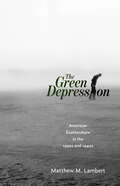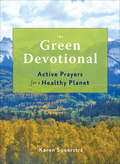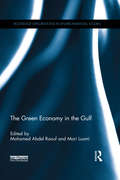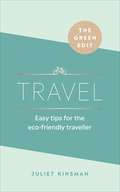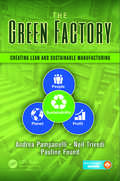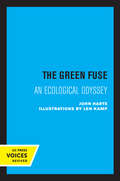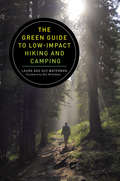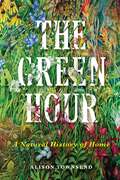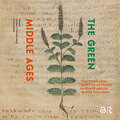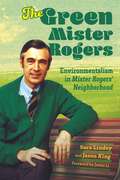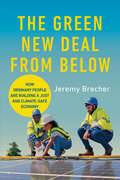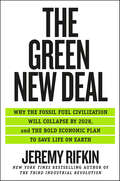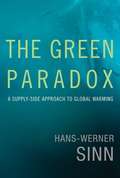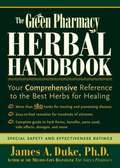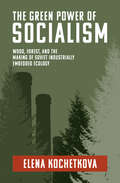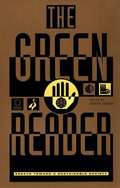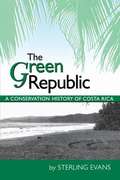- Table View
- List View
The Green Depression: American Ecoliterature in the 1930s and 1940s
by Matthew M. LambertDust storms. Flooding. The fear of nuclear fallout. While literary critics associate authors of the 1930s and ’40s with leftist political and economic thought, they often ignore concern in the period’s literary and cultural works with major environmental crises. To fill this gap in scholarship, author Matthew M. Lambert argues that depression-era authors contributed to the development of modern environmentalist thought in a variety of ways. Writers of the time provided a better understanding of the devastating effects that humans can have on the environment. They also depicted the ecological and cultural value of nonhuman nature, including animal “predators” and “pests.” Finally, they laid the groundwork for “environmental justice” by focusing on the social effects of environmental exploitation. To show the reach of environmentalist thought during the period, the first three chapters of The Green Depression: American Ecoliterature in the 1930s and 1940s focus on different geographical landscapes, including the wild, rural, and urban. The fourth and final chapter shifts to debates over the social and environmental effects of technology during the period. In identifying modern environmental ideas and concerns in American literary and cultural works of the 1930s and ’40s, The Green Depression highlights the importance of depression-era literature in understanding the development of environmentalist thought over the twentieth century. This book also builds upon a growing body of scholarship in ecocriticism that describes the unique contributions African American and other nonwhite authors have made to the environmental justice movement and to our understanding of the natural world.
The Green Devotional: Active Prayers for a Healthy Planet
by Karen SpeerstraOur planet, our home, is in crisis plain and simple and this collection of quotes, poems, essays, and prayers will inspire all to actively reverse the man-made cause of global warming, stem the tide of environmental destruction, and reconnect to the good earth. Short essays of topical interest introduce each of the eight sections of this book, and the 250 voices inside, most of them contemporary, begin to harmonize together as they seem to call out for their own canonical structure -- one bounded by the ancient elements: Earth, Air, Fire, Water. This collection of voices is like a "green book of devotional hours," reminiscent of the Books of Hours medieval people used to hold in their palms. It was called "a cathedral in your hands. " And like that medieval book, The Green Devotionalreminds us that we are connected to something broader and wiser than ourselves.
The Green Dog: A Mostly True Story
by Suzanne Fisher StaplesMy very own dog... All Suzanne can think of is her dream dog --- black-and-tan, with long silky fur and deep chocolate eyes. So when the perfect dog shows up one day, she is overjoyed. But Jeff, the dog, has a nose for trouble, and keeping him will be more difficult than Suzanne ever imagined.
The Green Economy and the Water-Energy-Food Nexus
by Robert C. BrearsThis book argues that a variety of policies will be required to create synergies between the water-energy-food nexus sectors while reducing trade-offs in the development of a green economy. Despite rising demand for water, energy and food globally, the governance of water-energy-food sectors has generally remained separate with limited attention placed on the interactions that exist between them. Brears provides readers with a series of in-depth case studies of leading cities, states, nations and regions of differing climates, lifestyles and income-levels from around the world that have implemented a variety of policy innovations to reduce water-energy-food nexus pressures and achieve green growth. The Green Economy and the Water-Energy-Food Nexus will be of interest to town and regional planners, resource conservation managers, policymakers, international companies and organisations interested in reducing water-energy-food nexus pressures, environmental NGOs, researchers, graduate and undergraduate students.
The Green Economy in the Gulf: Lessons From The Uae's State-led Energy Transition (Routledge Explorations in Environmental Studies)
by Mohamed Abdel Raouf Mari LuomiFilling a void in academic and policy-relevant literature on the topic of the green economy in the Arabian Gulf, this edited volume provides a multidisciplinary analysis of the key themes and challenges relating to the green economy in the region, including in the energy and water sectors and the urban environment, as well as with respect to cross-cutting issues, such as labour, intellectual property and South-South cooperation.Over the course of the book, academics and practitioners from various fields demonstrate why transitioning into a ‘green economy’ – a future economy based on environmental sustainability, social equity and improved well-being – is not an option but a necessity for the Gulf Cooperation Council (GCC) States. Through chapters covering key economic sectors and cross-cutting issues, the book examines the GCC states’ quest to align their economies and economic development with the imperatives of environmental sustainability and social welfare, and proposes a way forward, based on lessons learned from experiences in the region and beyond.This volume will be of great relevance to scholars and policy makers with an interest in environmental economics and policy.
The Green Edit: Easy tips for the eco-friendly traveller
by Juliet KinsmanExplore the world and satisfy your wanderlust in the most eco-friendly way.How can we lessen our impact on the world without giving up the things we love? This series of easy-to-follow guides show that positive change is possible without radical changes to your everyday life.Sustainable tourism doesn’t have to mean vowing to never take another flight or spending holidays camping in your back garden. This short expert guide from eco-travel journalist Juliet Kinsman, takes you through every step of planning your trip, from booking to boarding, and arms you with everything you need to know for a lower-impact getaway.Whether it's explaining how to know which plane to take (yes, some are greener than others) or how to avoid the mini toiletries trap; this book shows that you can save the planet and still live life to the full.
The Green Factory: Creating Lean and Sustainable Manufacturing
by Pauline Found Andrea Pampanelli Neil TrivediThis book proposes a new model, the Lean and Green Business Model (L&GBM), where the environmental aspect of sustainability is integrated with Lean thinking in order to create a way of thinking that contributes to and balances the three sustainability dimensions of people, profit, and planet. The model presented uses a kaizen approach that will
The Green Festival Reader: Fresh Ideas from Agents of Change
by Kevin Danaher Alisa GravitzThe Green Festivals now draw over 100,000 visitors every year in four U.S. cities. This book collects the most memorable talks from all four festivals on the most urgent social issues of the day.
The Green Fuse: An Ecological Odyssey
by John HarteA widely respected ecological scientist and activist draws on the poet's image and his own environmental research to demonstrate the many interconnections among the world's ecosystems. John Harte takes us from Alaskan salmon runs and the Florida everglades to South Pacific coral reefs and the bleak Tibetan plateau. The result is that rare book that bridges the cultures of science and art. Lyrical, vivid portraits of natural wonders and the threats to them are combined with precise scientific accounts of natural processes and their disturbances. The Green Fuse will show nonscientists the fascination of ecological detective work and renew scientists' love for the beauty of the world under their microscopes. Harte's stories illuminate, without sermonizing, the damage to natural systems brought about by technological hubris and calculated political ruthlessness. "The green fuse" symbolizes the basic unity behind natural diversity. But a fuse may also be the weak link in an overloaded system or the slow burning wick on an ecological bomb. As The Green Fuse reminds us, the energies that created human liberation from nature can also be those that lead to the human destruction of nature. This title is part of UC Press's Voices Revived program, which commemorates University of California Press’s mission to seek out and cultivate the brightest minds and give them voice, reach, and impact. Drawing on a backlist dating to 1893, Voices Revived makes high-quality, peer-reviewed scholarship accessible once again using print-on-demand technology. This title was originally published in 1993.
The Green Guide to Low-Impact Hiking and Camping
by Bill Mckibben Laura Waterman Guy Waterman"A classic of backpacking literature" (Backpacker), now updated with a brand-new foreword by environmentalist and best-selling author Bill McKibben Originally published as Backwoods Ethics in 1979, Laura and Guy Waterman's definitive guide to low-impact hiking and camping was a prophetic call to reevaluate the impact of outdoor recreation on the wilderness. Enthusiastically received by environmentalists and wilderness managers at the time, its warnings and advice are now more relevant than ever. With wisdom and gentle humor, Laura and Guy Waterman present a strong case for the importance of respecting the natural world while you're enjoying it. In his foreword to the new edition, world-famous environmentalist Bill McKibben puts the Watermans' advice into context for today's world. Day hikers, campers, and backpackers who follow the sensible techniques laid out in this book will help preserve the wilderness experience for generations to come.
The Green Hour: A Natural History of Home
by Alison TownsendWhen Alison Townsend purchased her first house, in south-central Wisconsin, she put down roots where she never imagined settling. To understand how she came to live in the Midwest, she takes a journey through personal landscapes, considering the impact of geography at pivotal moments in her life, vividly illuminating the role of mourning, homesickness, and relocations. With sparkling, lyrical prose, The Green Hour undulates effortlessly through time like a red-winged blackbird. Inspired by five beloved settings—eastern Pennsylvania, Vermont, California, western Oregon, and the spot atop the Wisconsin hill where she now resides—Townsend considers the role that place plays in shaping the self. She reveals the ways that a fresh perspective or new experience in any environment can incite wonder, build unexpected connections, and provide solace or salvation. Mesmerizingly attentive to nature—its beauty, its fragility, and its redeeming powers—she asks what it means to live in community with wilderness and to allow our identities to be shaped by our interactions with it: our story as its story.
The Green Leap
by Mark E. HostetlerWritten for anyone interested in green development--including policy makers, architects, developers, builders, and homeowners--this practical guide focuses on the central question of how to conserve biodiversity in neighborhoods and to minimize development impacts on surrounding habitats. The Green Leap specifically helps move green development beyond the design stage by thoroughly addressing construction and post-construction issues. Incorporating many real-world examples, Mark Hostetler explains key conservation concepts and techniques, with specific advice for a wide variety of stakeholders that are interested in creating and maintaining green developments. He outlines the key players and principles needed to establish biodiverse communities and illustrates eight key design and management strategies. The Green Leap not only offers essential information for constructing new developments but also helps existing communities retrofit homes, yards, and neighborhoods to better serve both people and nature.
The Green Middle Ages: The Depiction and Use of Plants in the Western World 600-1600 (CLAVIS Kunsthistorische Monografien)
by Claudine A. Chavannes-Mazel Linda IJpelaarHow 'green' were people in late antiquity and the Middle Ages? Unlike today, the nature around them was approached with faith, trust and care. The population size was many times smaller than today and human impact on nature not as extreme as it is now. People did not have to worry about issues like deforestation and sustainability. This book is about the knowledge of plants and where that knowledge came from. How did people use earth and plants in ancient times, and what did they know about their nutritional or medicinal properties? From which plants one could make dyes, such as indigo, woad and dyer's madder? Is it possible to determine that through technical research today? Which plants could be found in a ninth-century monastery garden, and what is the symbolic significance of plants in secular and religious literature? The Green Middle Ages addresses these and other issues, including the earliest herbarium collections, with a leading role for the palaeography and beautiful illuminations from numerous medieval manuscripts kept in Dutch and other Western libraries and museums.
The Green Mister Rogers: Environmentalism in Mister Rogers' Neighborhood (Children's Literature Association Series)
by Jason King Sara LindeyFred Rogers was an international celebrity. He was a pioneer in children’s television, an advocate for families, and a multimedia artist and performer. He wrote the television scripts and music, performed puppetry, sang, hosted, and directed Mister Rogers’ Neighborhood for more than thirty years. In his almost nine hundred episodes, Rogers pursued dramatic topics: divorce, death, war, sibling rivalry, disabilities, racism. Rogers’ direct, slow, gentle, and empathic approach is supported by his superior emotional strength, his intellectual and creative courage, and his joyful spiritual confidence. The Green Mister Rogers: Environmentalism in “Mister Rogers’ Neighborhood” centers on the show’s environmentalism, primarily expressed through his themed week “Caring for the Environment,” produced in 1990 in coordination with the twentieth anniversary of Earth Day. Unfolding against a trash catastrophe in the Neighborhood of Make-Believe, Rogers advances an environmentalism for children that secures children in their family homes while extending their perspective to faraway places, from the local recycling center to Florida’s coral reef. Rogers depicts animal wisdom and uses puppets to voice anxiety and hope and shows an interconnected world where each part of creation is valued, and love is circulated in networks of care. Ultimately, Rogers cultivates a practical wisdom that provides a way for children to confront the environmental crisis through action and hope and, in doing so, develop into adults who possess greater care for the environment and a capacious imagination for solving the ecological problems we face.
The Green New Deal and the Future of Work
by Raj Patel Harvey Molotch Harry C. Boyte Richard Lachmann Stephanie Luce Richard A. Walker Clark A. Miller Trygve Throntveit Alyssa Battistoni Daniel Aldana Cohen Hillary Angelo Olúfẹ́mi O. Táíwò Jim Goodman Wilson Sherwin Dustin Guastella Mindy Isser Todd E. Vachon J. Mijin Cha Lara SkinnerCatastrophic climate change overshadows the present and the future. Wrenching economic transformations have devastated workers and hollowed out communities. However, those fighting for jobs and those fighting for the planet have often been at odds. Does the world face two separate crises, environmental and economic? The promise of the Green New Deal is to tackle the threat of climate change through the empowerment of working people and the strengthening of democracy. In this view, the crisis of nature and the crisis of work must be addressed together—or they will not be addressed at all.This book brings together leading experts to explore the possibilities of the Green New Deal, emphasizing the future of work. Together, they examine transformations that are already underway and put forth bold new proposals that can provide jobs while reducing carbon consumption—building a world that is sustainable both economically and ecologically. Contributors also debate urgent questions: What is the value of a federal jobs program, or even a jobs guarantee? How do we alleviate the miseries and precarity of work? In key economic sectors, including energy, transportation, housing, agriculture, and care work, what kind of work is needed today? How does the New Deal provide guidance in addressing these questions, and how can a Green New Deal revive democracy? Above all, this book shows, the Green New Deal offers hope for a better tomorrow—but only if it accounts for work’s past transformations and shapes its future.
The Green New Deal from Below: How Ordinary People Are Building a Just and Climate-Safe Economy
by Jeremy BrecherA visionary program for national renewal, the Green New Deal aims to protect the earth’s climate while creating good jobs, reducing injustice, and eliminating poverty. Its core principle is to use the necessity for climate protection as a basis for realizing full employment and social justice. Jeremy Brecher goes beyond the national headlines and introduces readers to the community, municipal, county, state, tribal, and industry efforts advancing the Green New Deal across the United States. Brecher illustrates how such programs from below do the valuable work of building constituencies and providing proofs of concept for new ideas and initiatives. Block by block, these activities have come together to form a Green New Deal built on a strong foundation of small-scale movements and grassroots energy. A call for hope and a better tomorrow, The Green New Deal from Below offers a blueprint for reconstructing society on new principles to avoid catastrophic climate change.
The Green New Deal: Why the Fossil Fuel Civilization Will Collapse by 2028, and the Bold Economic Plan to Save Life on Earth
by Jeremy RifkinNew York Times–Bestselling Author: The renowned economic theorist explains how America can—and must—create a post-fossil fuel culture to survive.We can’t keep doing business as usual. Facing a global emergency, a younger generation has spearheaded a national conversation around a Green New Deal—a movement with the potential to revolutionize society. But while the Green New Deal has become a lightning rod in the political sphere, there is a parallel movement emerging within the business community that will shake the very foundation of the global economy in coming years.Key sectors of the economy are fast-decoupling from fossil fuels in favor of ever-cheaper solar and wind energies and the new business opportunities and employment that accompany them. New studies are sounding the alarm that trillions of dollars in stranded fossil fuel assets could create a carbon bubble likely to burst by 2028, causing the collapse of the fossil fuel civilization. The marketplace is speaking, and governments will need to adapt if they are to survive and prosper.In The Green New Deal, Jeremy Rifkin delivers the political narrative and economic plan for the Green New Deal that we need at this critical moment in history. The concurrence of a stranded fossil fuel assets bubble and a green political vision opens up the possibility of a massive shift to a post-carbon ecological era, in time to prevent a temperature rise that will tip us over the edge into runaway climate change. With twenty-five years of experience implementing Green New Deal–style transitions for both the European Union and the People’s Republic of China, Rifkin offers his vision for how to transform the global economy and save life on Earth.“The Green New Deal takes a stance quite different from that of typical Green New Deal supporters . . . he’s interested in building factories, farms, and vehicles in a fossil-free world, asserting that ‘the Green New Deal is all about infrastructure.’” —The New York Times Book Review“An urgent endorsement of efforts to remake a doomed fossil-fuel economy before it’s too late.” —Kirkus Reviews
The Green Paradox
by Hans-Werner SinnThe Earth is getting warmer. Yet, as Hans-Werner Sinn points out in this provocative book, the dominant policy approach--which aims to curb consumption of fossil energy--has been ineffective. Despite policy makers' efforts to promote alternative energy, impose emission controls on cars, and enforce tough energy-efficiency standards for buildings, the relentlessly rising curve of CO2 output does not show the slightest downward turn. Some proposed solutions are downright harmful: cultivating crops to make biofuels not only contributes to global warming but also uses resources that should be devoted to feeding the world's hungry. In The Green Paradox, Sinn proposes a new, more pragmatic approach based not on regulating the demand for fossil fuels but on controlling the supply. The owners of carbon resources, Sinn explains, are pre-empting future regulation by accelerating the production of fossil energy while they can. This is the "Green Paradox": expected future reduction in carbon consumption has the effect of accelerating climate change. Sinn suggests a supply-side solution: inducing the owners of carbon resources to leave more of their wealth underground. He proposes the swift introduction of a "Super-Kyoto" system--gathering all consumer countries into a cartel by means of a worldwide, coordinated cap-and-trade system supported by the levying of source taxes on capital income--to spoil the resource owners' appetite for financial assets. Only if we can shift our focus from local demand to worldwide supply policies for reducing carbon emissions, Sinn argues, will we have a chance of staving off climate disaster.
The Green Paradox: A Supply-Side Approach to Global Warming
by Hans-Werner SinnA leading economist develops a supply-side approach to fighting climate change that encourages resource owners to leave more of their fossil carbon underground.The Earth is getting warmer. Yet, as Hans-Werner Sinn points out in this provocative book, the dominant policy approach—which aims to curb consumption of fossil energy—has been ineffective. Despite policy makers' efforts to promote alternative energy, impose emission controls on cars, and enforce tough energy-efficiency standards for buildings, the relentlessly rising curve of CO2 output does not show the slightest downward turn. Some proposed solutions are downright harmful: cultivating crops to make biofuels not only contributes to global warming but also uses resources that should be devoted to feeding the world's hungry. In The Green Paradox, Sinn proposes a new, more pragmatic approach based not on regulating the demand for fossil fuels but on controlling the supply.The owners of carbon resources, Sinn explains, are pre-empting future regulation by accelerating the production of fossil energy while they can. This is the “Green Paradox”: expected future reduction in carbon consumption has the effect of accelerating climate change. Sinn suggests a supply-side solution: inducing the owners of carbon resources to leave more of their wealth underground. He proposes the swift introduction of a “Super-Kyoto” system—gathering all consumer countries into a cartel by means of a worldwide, coordinated cap-and-trade system supported by the levying of source taxes on capital income—to spoil the resource owners' appetite for financial assets.Only if we can shift our focus from local demand to worldwide supply policies for reducing carbon emissions, Sinn argues, will we have a chance of staving off climate disaster.
The Green Pharmacy Herbal Handbook
by James O. DukeIn this handy companion to his best-selling book The Green Pharmacy, leading herbal authority James A. Duke, Ph.D.., delivers the lowdown on virtually every healing herb available in today's marketplace: its description and history, therapeutic uses, medicinal properties, prescription counterparts, dosage options, safety and effectiveness rating, and precautions. Dr. Duke's inimitable folksy tone and friendly manner shine throughout The Green Pharmacy Herbal Handbook, making it as entertaining to read as it is practical. The most thorough,and comprehensive herb reference of its kind, the handbook was culled from the thousands of entries in Dr. Duke's database of the world's medicinal plants. The database, which he began during his career as a top botanist with the USDA, is a lifelong project for Dr. Duke and has become a major reference resource for herbalists worldwide.
The Green Planet: (ACCOMPANIES THE BBC SERIES PRESENTED BY DAVID ATTENBOROUGH)
by Simon BarnesPraise for The Green Planet (BBC One)'David Attenborough's gobsmacking, awe-inspiring return' The Guardian'The Green Planet reveals the secret lives of plants in the same way The Blue Planet opened our eyes to the oceans' New ScientistThere's something new under the sunPlants live secret, unseen lives - hidden in their magical world and on their timescale. From the richest jungles to the harshest deserts, from the snowiest alpine forest to the remotest steaming swamp, Green Planet travels from one great habitat to the next, showing us that plants are as aggressive, competitive and dramatic as the animals on our planet. You will discover agents of death, who ruthlessly engulf their host plant, but also those that form deep and complex relationships with other species, such as the desert cacti who use nectar-loving bats to pollinate. Although plants are undoubtedly the stars of the show, a fascinating new light will be shed on the animals that interact with them.Using the latest technologies and showcasing over two decades of new discoveries, Green Planet reveals the strange and wonderful life of plants like never before - a life full of remarkable behaviour, emotional stories and surprising heroes.
The Green Power of Socialism: Wood, Forest, and the Making of Soviet Industrially Embedded Ecology (History for a Sustainable Future)
by Elena KochetkovaHow the Soviet forestry industry developed a unique form of industrial ecology—a commonsense approach toward natural resources for the economy and society.In The Green Power of Socialism, Elena Kochetkova examines the relationship between nature and humans under state socialism by looking at the industrial role of Soviet forests. The book explores evolving Soviet policies of wood consumption, discussing how professionals working in the forestry industry of the Soviet state viewed the present and future of forests by considering them both a natural resource and a trove of industrial material. When faced with the prospect of wood shortages, these specialists came to develop new industry-ecology paradigms. Kochetkova looks at the materiality of Soviet industry through forests and wood to show how, paradoxically, industrial ecology emerged and developed as a by-product of the Soviet industrialization project.The Green Power of Socialism also discusses how post-Soviet industry has abandoned these socialist practices and the idea of nature as a complicated ecosystem that provides a crucial service to society. Emphasizing the technological and environmental impacts of the Cold War, Kochetkova critically reconsiders two explanatory models that have become dominant in the historiography of Soviet approaches to nature over the last decades—ecocide and environmentalism. Within the context of the current environmental crisis, the book invites readers to reevaluate state socialism as a complex phenomenon with sophisticated interactions between nature and industry. In so doing, it contributes a fresh perspective on the activities of socialist experts and their view of nature, shedding light on Soviet state industrial and environmental policy and its continuing legacy in the present day.
The Green Reader: Essays Toward a Sustainable Society
by Andrew DobsonThe Green Reader collects key source documents of today's most important social/scientific/philosophical movement-the Green movement.
The Green Republic: A Conservation History of Costa Rica
by Sterling EvansWith over 25 percent of its land set aside in national parks and other protected areas, Costa Rica is renowned worldwide as "the green republic. " In this very readable history of conservation in Costa Rica, Sterling Evans explores the establishment of the country's national park system as a response to the rapid destruction of its tropical ecosystems due to the expansion of export-related agriculture. Drawing on interviews with key players in the conservation movement, as well as archival research, Evans traces the emergence of a conservation ethic among Costa Ricans and the tangible forms it has taken. In Part I, he describes the development of the national park system and "the grand contradiction" that conservation occurred simultaneously with massive deforestation in unprotected areas. In Part II, he examines other aspects of Costa Rica's conservation experience, including the important roles played by environmental education and nongovernmental organizations, campesino and indigenous movements, ecotourism, and the work of the National Biodiversity Institute.
The Green Revolution
by Norman NadeauEver Wonder What A Green Renewable Sustainable World Would Look Like?With the state of our world and its limited resources, more and more people are trying to lead a greener lifestyle in order to do their part. The Green Revolution provides comprehensive information associated with adopting daily practices that will ultimately sustain, not deplete, precious natural materials in an ever-growing population.Renewable energy expert Norman Nadeau leads by example as he details how he has committed his life to living green. From the application of solar and wind turbine technology, to recovering energy embedded in places one may not expect (such as animals' manure), The Green Revolution highlights the highly sustainable system Norman Nadeau developed for his family farm.The Green Revolution serves as a broad introduction for those who want to conserve rather than squander. At this very important turning point in our planet's history, this book offers the principles by which anyone can live in the most sustainable way possible.
